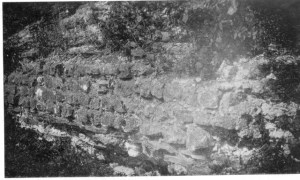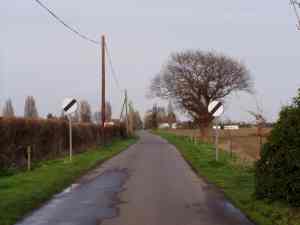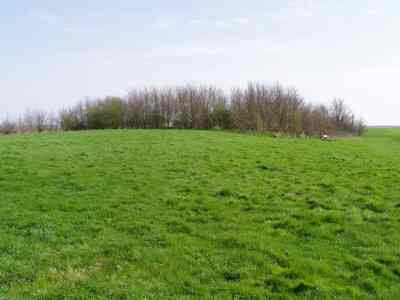The Roman Fort of Othona at Bradwell on Sea

Part of the roman wall at Othona pictured
in about 1900
Othona is one of 9 forts that were
constructed in the 3rd century AD to deal with the treat posed by
the Saxon raiders.
It is likely that the Fort was
built by a Roman Commander called
Carausius who for a period
revolted against Rome and declared himself Emperor of Britain.
Othona was almost rectangular
in shape covering an area of up to 4 acres.
The fort was heavily defended
and would have taken the form of a defensive ditch
8 feet deep and 20 feet wide.
The walls were about 20 feet high and 14 feet wide allowing sentries
and defenders to walk the walls.
Towers would have been sited
at each corner and intervals on the straight sections.
The outline of the west wall
has been measured at 522 feet long.
Then there would have been an
inner earth mound and living quarters within the walls probably in
the north west quarter.
The existing St Peters Chapel
is built on the site of the Porta Praetoria which was the main
gateway on the western wall..
Transport would have been by
road and to the Quay which is believed to have been
on the eastern side of the Fort in an area now covered by sea.
Whilst no road has been
positively identified the area had a comparatively heavy density of
roman occupation.
As the area would have been
split between marshland , pasture and heavy forestation it is likely
that a road would have been built to allow quick access by the roman
soldiers..
There is some evidence to support a road
from Othona to the River Crouch near Battlesbridge where there were
roman potteries and there was a possible crossing to the Roman
settlements and burial ground on Foulness Island.
The road then followed the
River Crouch past the Roman Kilns at Norsey Wood, Billericay to join
up with the main North South roman road near to Brentwood.

East End Road leading to the old fort of
Othona
Being marshy East Essex has more than its
share of bendy roads bit from Othona there are a few
uncharacteristically straight sections of road that are out of place
considering natural characteristics.
Coins and pottery found at the
site have dated from 280 AD to 468 AD which tends to indicate that
they were built during the later years of roman occupation.
Although coins of 24
Emperors from Gallienus to Honoriuus, have been found at this site,
many of the coins bear the head of Carausius.
Excavations have taken place
in 1864 and 1947. Following a geophysical survey further excavations
of this site are planned.
Notitia Dignitatum is a fourth
century roman book which records the military dispositions of the
empire.
Othona is listed as one of 9
forts defending the coast against the Saxon threat.
The garrison was not drawn
from legionnaires but normally from axillaries drawn from countries
colonised by Rome although as time passed they would have been
supplement from men drawn from the indigenous population.
The troops at Othona were
called the Limen Fortenses who were light cavalry rather than the
normal foot soldiers.
Perhaps light cavalry were
stationed at Bradwell to protect the many valuable Roman Villas and
farms that were to be found in the fertile land midway between two
of the most important Roman towns of Colchester and London.
The roman withdrawal from this
island abandoned Othona which by AD 650 was used to build St Peters
Chapel.
There is some suspicion that flooding from
a very high tide in November 1099 may have reduced Othona to ruins
from which it never recovered

Nowadays there is
little to be seen of Othona, about 2m stretch of the lower section
of the wall remains although it is covered by scrub land.

